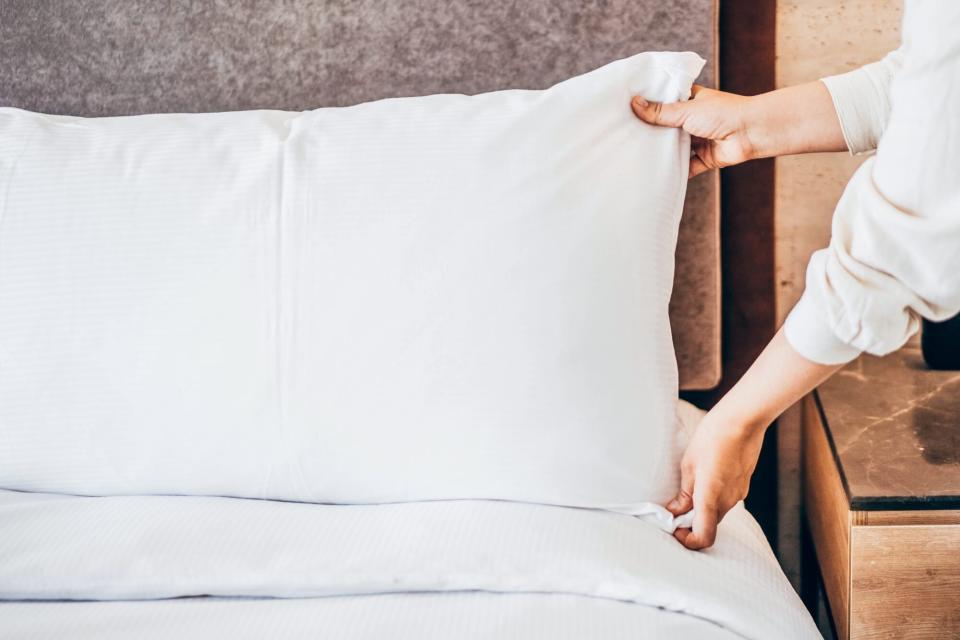How to Wash Pillows the Right Way

TABLE OF CONTENTS
On This Page
Washing Frequency
How to Wash Pillows
Drying
When to Replace
When it comes to bedding, you're probably meticulous about cleaning your sheets and comforter, but can the same be said for your pillows? A mix of dead skin and dust mites can build up on and inside your pillows, so it's important to make sure they receive just as much attention as anything else on your bed. To ensure your pillows stay fresh, we asked cleaning and bedding experts for their best tips on cleaning and caring for this essential element of the bed.
Related: The Best Pillows for Side Sleepers, Back Sleepers, and Everyone in Between

Maria Korneeva / GETTY IMAGES
How Often Should You Wash Pillows?
While you'll want to wash the rest of your bedding weekly, pillows have a longer grace period. At the very least, clean your pillows every six months—but to keep them in their best condition for longer, wash them "at least every three months or four times a year," says Brian Sansoni, senior vice president of communications, outreach, and membership at the American Cleaning Institute. As for pillowcases? Wash them with your bedding every week.
How to Wash Pillows
Most pillows, including those filled with cotton, feather, down, and fiberfill, can be cleaned in a washing machine using warm water on the gentle cycle, but it's always a good idea to read the label for cleaning instructions first. "Your pillow may be one of the rare kinds that need dry-cleaning," says Sansoni.
Materials You'll Need
Gentle laundry detergent
White vinegar
Here's an expert-approved way to wash your pillows:
If the pillow has blood or saliva stains, pre-treat them with digestants (enzyme-containing detergents) to remove them.
Most pillows can be machine washed, preferably with a front- or top-loading machine without an agitator (the spindle in the center of the washing machine). If you have a top-loading machine with an agitator, add the pillows in vertically so they're less likely to get damaged, says Sansoni.
Add a gentle, clear detergent to the washing machine and wash with hot water on the gentle cycle if possible, says Kathy Cohoon, the director of franchise operations at Two Maids.
After the rinse cycle, use the spin dry feature of your washer at least twice to get as much moisture out of the pillows as possible, says Sansoni.
After the wash cycle, dry your pillows on low heat. "To avoid pillows getting lumpy, throw two (clean!) tennis balls or wool dryer balls in the dryer with the pillow to keep stuffing from clumping," says Cohoon.
Pro tip: "To 'recharge' your pillows and freshen them up in between deep cleanings, you can also run the pillows through the washing machine on a gentle, warm water cycle with 1/2 cup of white vinegar," says Cohoon.
Foam Pillows
Foam pillows should never go into the washing machine. The agitation is too harsh and will likely break up the padding. Foam pillows should also always be paired with a pillow protector, which help preserve their quality and protect them from sweat and dust, says Katie Elks, design director at Brooklinen.
Materials You'll Need
Vacuum
Gentle laundry detergent
Stain remover
Use a vacuum attachment to remove dirt or dust from the pillow.
Spot treat foam pillows with a mixture of water and laundry detergent or use a gentle stain remover for tougher stains.
Down Pillows
While down pillows can typically be cleaned in the washing machine, you'll still want to check their fabric care label; always use a delicate wash setting and cool water. "Launder two of them at the same time in order to help keep your washing machine balanced during the spin cycle," says Sansoni.
If you notice any stains, use the stain removal technique mentioned above and skip dry cleaning, which will actually shorten the lifespan of the down pillow. "The chemicals remove the natural oils in the down and the clusters will break down faster," says Elks.
How to Dry Pillows
It's perfectly fine to allow your pillows to air-dry. You can also give them some time in the dryer depending on what the cleaning instructions on the label say. (Foam pillows, for example, pose the risk of catching fire when they come into contact with heat.) If you can use your dryer, Sansoni recommends running pillows through several cycles to ensure they dry all the way through. "When drying, remove pillows and fluff them periodically to prevent clumping and promote even drying," says Sansoni. "Tossing a few tennis or dryer balls in the dryer with the pillows will also help prevent clumping."
When to Replace Pillows
Since pillows accumulate bacteria, hair, and dead skin cells over time, they have a high turnover rate. "Since they can host bacteria and are usually used daily, pillows should be replaced every year and a half to two years maximum," says Cohoon. This timeframe is further backed by the National Sleep Foundation, although it's important to note that certain types of pillows can last longer.

